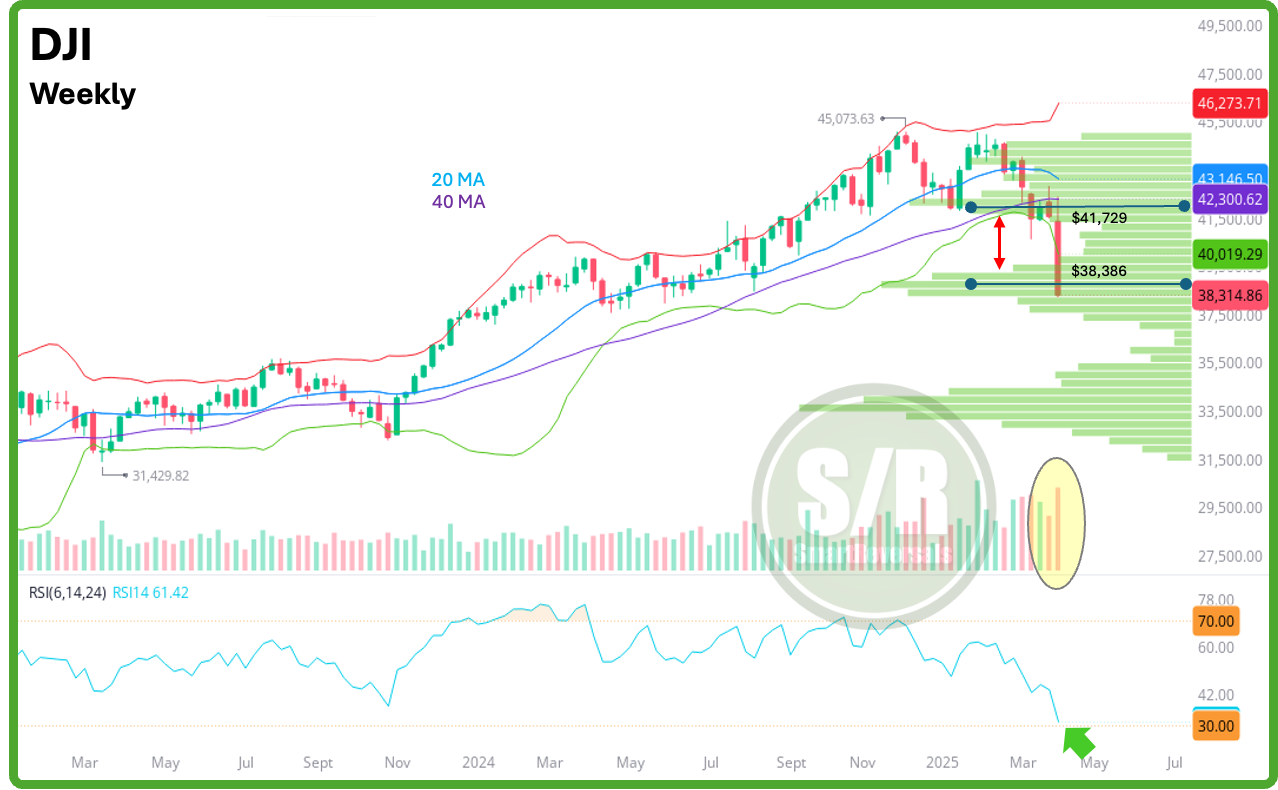How to Make Money in Bear Markets?
Analyzing 20+ Securities: Technical Setups and Price Targets for U.S. Indices, Stocks, Crypto & Commodities. 3 essential levels for each security.
Now that the NDX has declined -21.7% from its top, we can officially use the term bear market. During the last two months I have posted content with warning and confirmation signals for a major top, you can access using the links below.
Navigating the Market's Tides: The Power of Elliott Wave Analysis
Navigating Market Crossroads: A Technical Study of Historical Corrections
Bearish Crossover and Divergence Analysis: Market-Wide Implications
Those five publications alone are worth the subscription, they will teach you much more than a book. Since we will use the term Support and Resistance, this content is also essential:
How to be Profitable in Bear Markets?
Profiting in bear markets using technical analysis requires a shift in mindset and strategy compared to bull markets. Instead of primarily looking for buying opportunities, an investor will focus on identifying and capitalizing on downward trends. Here's how technical analysis can guide:
1. Identifying the Bear Market (We have been studied this):
Trend Identification: The most fundamental aspect is recognizing that the primary trend is down. Look for lower highs and lower lows on price charts across various timeframes. The educational content above approached the bearish signals in daily, weekly, and monthly timeframes.
Bearish Crosses: The 50-day and 200-day simple moving averages (SMAs) are crucial. A "death cross," where the 50-day SMA crosses below the 200-day SMA, is a classic bearish signal. Trading below these averages indicates bearish control. The signal has not yet happened for SPX nor NDX given the velocity of the selloff, but the MACD cross is a fact in long timeframes, as studied in one of the linked publications above.
Volume Analysis: Increasing volume on down days and decreasing volume on up days (bear market rallies) confirms bearish sentiment and suggests continued selling pressure.
2. Strategies for Profiting (We will continue studying this using technical charts):
Short Selling: This is a primary strategy in bear markets. Technical analysis helps identify strong candidates for short selling:
Breakdown of Support Levels: When a price breaks decisively below a significant support level (identified through trendlines, previous lows, or Support and Resistance levels) with increasing volume, it signals potential for further decline.
Overbought Conditions with Bearish Divergence: Identifying when an asset is overbought (using indicators like RSI or Stochastics) while showing bearish divergence (price making higher highs, but the indicator making lower highs) can signal an impending reversal.
Resistance Levels: Short selling near established resistance levels offers a defined risk-reward profile, with a stop-loss order placed above the resistance and analyzing the price action to assess probabilities (candles).
Buying Put Options: If a trader prefers not to short sell directly, buying put options allows to profit from a decline in price with limited risk (the premium paid for the option). Technical analysis helps in determining the appropriate strike price and expiration date based on expected price targets and timeframes.
Trading Inverse ETFs: Inverse Exchange-Traded Funds (ETFs) are financial instruments designed to provide returns that are the inverse of the performance of a specific index or sector. This means that when the underlying asset goes down, the inverse ETF is designed to go up. You can apply the same technical analysis principles used for traditional stocks and ETFs to inverse ETFs.
Identifying Entry Points: Bearish signals on the underlying index or sector chart must be identified (e.g., breakdown of support, bearish patterns, negative divergence). These signals can indicate a potential upward move in the corresponding inverse ETF. For example, if the S&P 500 (SPX) breaks below a key support level, a trader or investor can consider a long entry in an inverse S&P 500 ETF (like SH, SDS, or SPXU, depending on the desired leverage).
Setting Price Targets and Stop-Losses: Use resistance levels on the underlying asset's chart (which would act as potential support for the inverse ETF) to set profit targets. Placing stop-loss orders on the inverse ETF chart at levels that would invalidate the bearish thesis on the underlying asset.
Trading Bear Market Rallies (Cautiously): Inverse ETFs can also be used tactically during bear market rallies. If you anticipate a rally in the broad market is likely to fail at a certain resistance level, you could consider a short-term long position in an inverse ETF, expecting it to move higher as the rally fades. However, this requires careful timing and a clear understanding of potential reversal points.
Example: If the Nasdaq 100 (NDX) shows a bearish pattern forming below its 50-day moving average, indicating potential for further downside, a trader might consider buying shares of an inverse Nasdaq 100 ETF (like QQQ short ETFs such as PSQ, SQQQ). The technical analysis on the NDX chart provides the rationale for the trade in the inverse ETF. Be mindful that some ETFs are leveraged and they amplify losses if price goes in the wrong direction.
In the content below we will assess the risk of shorting, buying put options, or buying inverse ETFs based on today’s charts, those instruments demand high technical expertise and use of Support and Resistance Levels.
Observing Short-Term Reversal Setups for Bear Market Rallies:
Bear markets are characterized by sharp declines punctuated by often strong, but temporary, upward movements known as bear market rallies. Profiting from these rallies requires identifying potential reversal points and trading them for short durations. Here is how to Identify Potential Rally Points:
Oversold Conditions: Look for assets or indices entering oversold territory on short-term momentum indicators as the ones studied in this publication.
Support Levels: Identify short-term support levels using previous minor lows, short-term trend-lines, or Support and Resistance levels as the ones posted every week. For the S/R levels published yesterday for next week, click here .
Positive Divergence: Watch for positive divergence on short-term charts, where the price makes lower lows, but a momentum indicator makes higher lows. This can be an early signal of weakening downward momentum and a potential reversal.
Short Covering: Sometimes, significant short covering can fuel sharp, short-term rallies. While difficult to predict directly with technical analysis, observing strong upward moves with increasing volume after a period of decline can suggest short covering is underway.
Confirmation: Wait for confirmation of a reversal, such as a break above a short-term downtrend line or a bullish candlestick pattern forming at a support level.
Setting Short-Term Targets: Identify potential resistance levels where the rally might stall (e.g., previous minor highs, short-term moving averages, S/R levels).
Tight Stop-Losses: Due to the counter-trend nature of these trades, use tight stop-loss orders below the reversal point to protect capital if the rally fails quickly.
Being Quick and Nimble: Bear market rallies can be fast and short-lived. Staying prepared to take profits quickly when the target is reached is essential; or if signs of the rally faltering emerge.
Example: An individual stock in a bear market might experience a sharp decline, pushing its daily RSI into oversold territory while bouncing off a short-term support level. A trader might initiate a short-term long position, placing a stop-loss below the support and targeting the next resistance level as a potential resistance line for taking profits.
3. Risk Management is Paramount:
Stop-Loss Orders: Crucial for limiting potential losses on short positions or put options if the market moves against you. Placing stop-loss orders strategically above resistance levels for shorts or at a predetermined percentage loss for options.
Position Sizing: Reducing position sizes compared to bull market trading is common, as volatility can lead to larger and faster price swings.
Avoid Chasing Rallies: Be wary of strong upward movements (bear market rallies). Technical analysis can help determine if these are likely to be short-lived by looking at resistance levels, volume, and momentum. Often, these rallies provide better entry points for short positions.
Be Flexible: Bear markets can be unpredictable. Be prepared to adjust your analysis and strategy as market conditions evolve.
4. Patience and Discipline:
Wait for Confirmation: Don't jump into trades based on a single indicator or pattern. Look for Support and Resistance levels for validation.
Stick to Your Plan: Define your entry and exit criteria based on technical analysis and adhere to them. Avoid emotional trading.
Understand Bear Market Psychology: Fear and panic often drive bear market selling. Be aware of potential "bear traps" (false signals of a bottom) and "sucker rallies." (false signals of a top).
Anticipating Moves in Bear Markets with Technical Analysis
Let’s begin with the charts, they are the best tool to anticipate moves, and the S/R Levels for assessing potential reversals.
DOW JONES: The chart presents how fast price action can move between volume shelves (red arrow). Last week, this publication highlighted the significance of the $41,7K zone considering the confluence of annual level, and the volume gap below it. Since the Bollinger band was widening.
Support and resistance levels are instrumental in gauging potential price targets and safeguarding capital. To illustrate: Last week's central level was $41,978.6; this publication suggested that maintaining price above this point would favor a bullish continuation towards $42,427.2. Indeed, by Wednesday, the price peaked close to this area, reversing at $42,382.3. Subsequently, when the price decline broke below $41,978.6, a sell signal was confirmed, providing a rationale to close any existing long positions. Even if this action seemed belated, it could have prevented the losses experienced on Thursday during market hours and the subsequent Friday selloff.
The setup for next week looks bearish considering the candle and weekly volume highlighted. Further bearish movement is expected if price stays below $39,654, potentially leading to a target of $36,925.7; however, a recovery above $39,654 could signal a bullish reversal aiming for $41,043.1. See that price reached the lower volume shelf and price is oversold relative to the Bollinger bands.
The same in-depth charts and analysis describing the current setups, with price targets and key support and resistance levels continues for SPX, VIX, NDX, IWM, SMH, PLTR, DXY, GLD, SLV, TLT, MSTR, GOOG, AAPL, NVDA, META, MSFT, TSLA, AMZN, and BTC; with volatility and breadth indicators analyzed. If you actively invest or trade any of these securities, this publication is essential for making informed investment decisions.
SPX - Is this a Setup to Short?
The answer applies for the Dow Jones chart as well with the levels mentioned:





